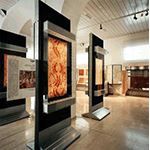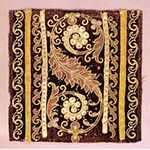Museo del Tessuto [Textile Museum]
The manufacturing industry of Prato boasts a tradition that sinks its roots in the early 12th century, the period from which we have the first news of the presence of plants for wool manufacture. The economic prosperity of textiles ended in the 15th century. Following a standstill owing to the sack of Prato in 1512, and to the rigid restrictions of the Wool Merchants Guild, manufacture was relaunched thanks to the efficient legislative measures introduced by the Lorraines. In the early 19th century, the textile machines made in the workshop of Giovan Battista Mazzoni introduced the most advanced technologies for the epoch, putting the Prato industry in step with the greatest European productions. The same period saw the institution, in Prato, of a school of elementary mathematics applied to the arts, «a very important school for this manufacturing city [that] - as Repetti recalls in his Dizionario geografico fisico storico della Toscana - can be considered the Manchester of the Grand Duchy and the manufacturing emporium of Tuscany».
The great manufacturing tradition of Prato is today documented by the Textile Museum, unique in Italy for its wealth of materials. Founded in 1975 following the donation of more than 600 pieces by businessman and collector Loriano Bertini from Prato, the collections were then enlarged thanks to public and private contributions. In May 2003, the Museum was transferred to its new venue in the former Cimatoria Campolmi, a nineteenth-century textile factory that remained in operation until 1990 circa, purchased and restored by the Communal Administration of Prato.
The Museum, which occupies a wing of the ex industrial complex, has received a completely new layout, proposing a new and more articulate exhibition itinerary. The historical collection comprises antique fabrics (about 5000 exhibits), from the 3rd century to the 19th century, from various geographical areas, both European and extra European. The contemporary collection (about 3000 exhibits) presents fabrics and collections of samples of the Prato textile industry, ranging from the late 19th century till today. Finally, the collection of weaving tools (about 100 exhibits from the 18th to the 20th century) also includes several instruments for hand-weaving, such as spinning wheels, cone-winding frames and trestles for scotching hemp. The collection is also enriched by dynamometers, hat-blocks for fezzes, and a tearing machine from 1850 to recover textile fibre from rags.
The Museum Library conserves valuable and rare editions, in addition to anastatic reprints. The Prato institution conducts an intense educational and research activity, availing itself of a learning workshop which addresses schools of every kind and grade, and formative activities for adults.
The institution’s management is entrusted to the Textile Museum Foundation whose founding members are the Commune and Province of Prato, the Industrial Union of Prato, the Chamber of Commerce, Industry and Handicrafts of Prato, and Cariprato.
****************************
Texts by Graziano Magrini
English translation by Victor Beard
Last update 27/feb/2008





